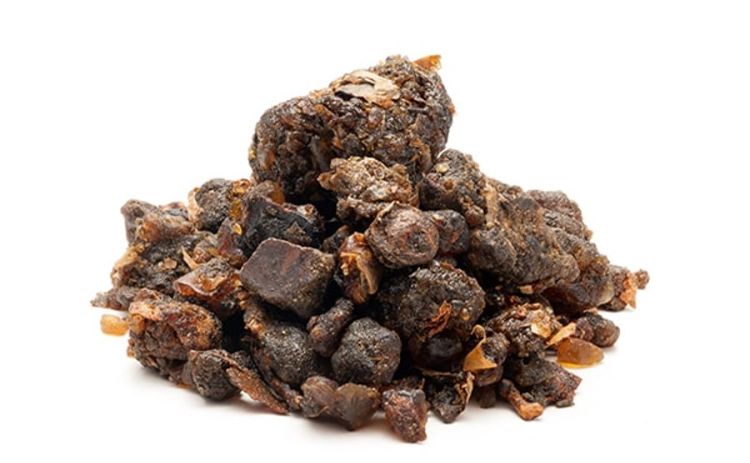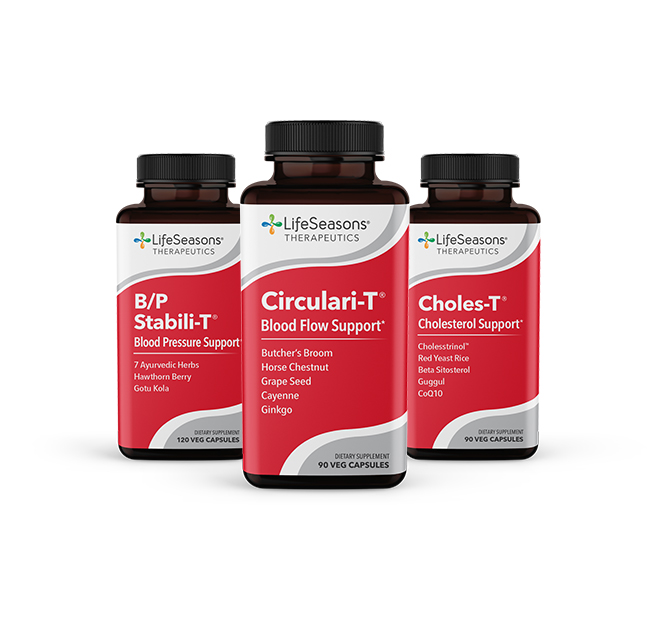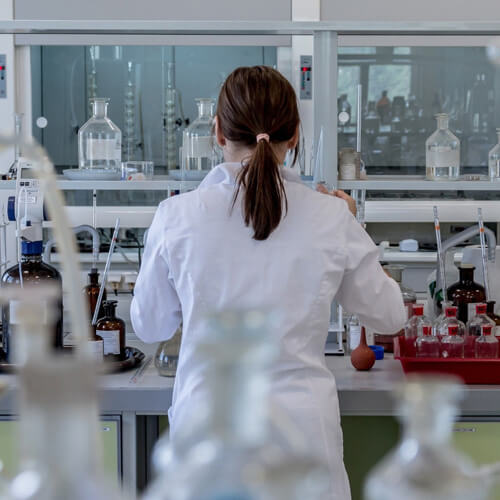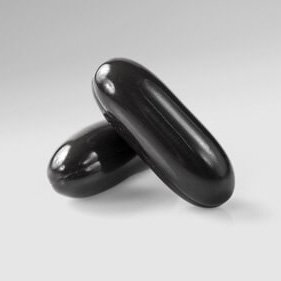BACKGROUND
Ingredient Type: Botanical, Extract, Constituent
Also Known As: Commiphora mukul, Guggalipid, Guggul gum resin, Guggul lipids, Indian bdellium-tree, Koushika, Mukul myrrh tree, Palankasha

Guggul is a shrub most commonly found in India, where its gummy resin is used in Ayurvedic medicine to help manage cholesterol levels.
Guggulsterone is a phytosteroid found in the resin of the guggul plant. This phytosteroids and the resin from which it is derived have been used to treat various diseases including hypercholesterolemia, atherosclerosis, rheumatism, and obesity for thousands of years.
Guggulsterone is thought to be the bioactive constituent of the plant that is responsible for its therapeutic effects.
TRADITIONAL USES
Guggul is most commonly used as a health supplement today to support liver function, cholesterol metabolism, and healthy joints.
WHAT DOES SCIENCE TELL US?
Since the first study demonstrating the therapeutic effects of guggul in an animal model in 1966, numerous preclinical and clinical trials have been carried out.
Antibacterial effects: The essential oil, chloroform extract, and seven sesquiterpenoids compounds isolated from the oleo-gum-resin of Commiphora mukul have displayed a wide range of inhibitory activity against both Gram-positive and Gram-negative bacteria (8).
Anticoagulant/antiplatelet effects: Guggulipid administration has been associated with the inhibition of platelet aggregation and increased fibrinolysis (9).
Antidiabetic effects: In animal research, guggulipid demonstrated peroxisome proliferator-activated receptor-alpha (PPAR-alpha), PPAR-gamma, and liver X receptor-alpha (LXR-alpha) agonist activity which can contribute to antidiabetic effects (10). Commiphoric acid was also found to activate PPAR-alpha and PPAR-gamma.
Anti-inflammatory effects: In animal and human research, guggul exerted anti-inflammatory effects (11). Guggulsterone [4,17(20)-pregnadiene-3,16-dione] isolated from Commiphora mukul has been used to treat osteoarthritis, bone fractures, and inflammatory bowel disease, and was shown to antagonize the farnesoid X receptor, decrease the expression of bile acid-activated genes, and suppress nuclear factor (NF)-kappaB activation (12). Guggulsterone has also been shown to suppress several inflammatory mediators and cell-signaling intermediates, including interferon (IFN)-gamma, interleukin (IL)-12, nitric oxide (NO), proinflammatory cytokines (e.g., tumor necrosis factor [TNF] and IL-1beta) and proinflammatory enzymes that mediate the production of prostaglandins (e.g., cyclooxygenase (COX)-2) and leukotrienes (e.g., lipoxygenase), together with the expression of adhesion molecules and matrix metalloproteinases, and hyperproliferation of synovial fibroblasts (13). Possible effects on high-sensitivity C-reactive protein (hs-CRP) have been observed in clinical research as well (14).
Antiobesity effects: Guggul has been commonly noted as one of the components of various traditional Ayurvedic formulations to treat obesity (15). In human research, guggul demonstrated weight loss effects (16). Guggul combination products have also been used in a clinical trial, resulting in antiobesity effects (17). The exact mechanisms of action are unclear.
Antioxidant effects: In lab and animal research, guggul extracts have been reported to possess antioxidant properties (18), which have been suggested as possibly mediating protection against myocardial necrosis (19). Other animal research has indicated that guggulipid can inhibit streptozotocin-induced deficits in memory and that these effects might be due to the antioxidant and anti-acetylcholinesterase activity of guggulipid (19).
Cardiovascular effects: In human research, coadministration of Commiphora mukul and Inula racemosa (Pushkarmool) improved lipid profile, normalized electrocardiogram (ECG) output, and mitigated symptoms of dyspnea and chest pain in patients with ischemic heart disease (21).
Lipid effects: Guggulipid extracted from guggul using ethyl acetate has demonstrated hypolipidemic effects in clinical practice (20). Typical guggulipid preparations have been reported to contain 2.5-5% of theplantsterolsguggulsterones E and Z, and they have also been reported to exert antilipemic effects (22). Several hypotheses have been advanced to explain these effects. In a review of preclinical and clinical research, guggulsterone demonstrated upregulation of the bile salt export pump (BSEP), thereby promoting the metabolism of cholesterol into bile acids (23). Guggulsterones, particularly 4,17(20)-pregnadiene-3,16-dione, have also been reported to function as antagonists of the farnesoid X receptor (FXR) and the bile acid receptor (BAR), nuclear hormones that are involved with cholesterol metabolism and bile acid regulation (22).
SAFETY
Standardized guggulipid is generally regarded as being safe in healthy adults at normal doses for up to six months. The prepared gum resin is also likely safe when used orally and appropriately. It has been used safely in clinical trials for up to 24 weeks. Limited evidence also suggests that long-term use up to 75 weeks may be safe (6,7).
Interactions:
Major
Guggul is believed to interact with estrogens (5)
Moderate
Guggul may interact with anticoagulant/antiplatelet drugs; contraceptive drugs; cytochrome P45 3A4 substrate drugs; Diltiazem, Propranolol; tamoxifen, thyroid hormone (5)
REFERENCES
- Deng, R. Therapeutic effects of guggul and its constituent guggulsterone: cardiovascular benefits. Cardiovasc.Drug Rev. 2007;25(4):375-390.
- Singh RB, Niaz MA, Ghosh S (1994) Hypolipidemic and antioxidant effects of Commiphora mukul as an adjunct to dietary therapy in patients with hypercholesterolemia. Cardiovasc Drugs Ther8:659-664.
- Singh RB, Niaz MA, Ghosh S (1994) Hypolipidemic and antioxidant effects of Commiphora mukul as an adjunct to dietary therapy in patients with hypercholesterolemia. Cardiovasc Drugs Ther8:659-664.
- Wang X, Greilberger J, Ledinski G, Kager G, Paigen B, Jürgens G (2004) The hypolipidemic natural product Commiphora mukul and its component guggulsterone inhibit oxidative modification of LDL. Atherosclerosis172:239-246
- Https://naturalmedicines.com
- Szapary PO, Wolfe ML, Bloedon LT, et al. Guggulipid for treatment of hypercholesterolemia: a randomized controlled trial. JAMA 2003;290:765-72.
- Malhotra SC, Ahuja MM, Sundaram KR. Long term clinical studies on the hypolipidaemic effect of Commiphora mukul (Guggulu) and clofibrate. Indian J Med Res 1977;65:390-5
- Saeed, M. A. and Sabir, A. W. Antibacterial activities of some constituents from oleo-gum-resin of Commiphora mukul. Fitoterapia 2004;75(2):204-208
- Bordia, A. and Chuttani, S. K. Effect of gum guggulu on fibrinolysis and platelet adhesiveness in coronary heart disease. Indian J Med Res 1979;70:992-996
- Cornick, C. L., Strongitharm, B. H., Sassano, G., Rawlins, C., Mayes, A. E., Joseph, A. N., O’Dowd, J., Stocker, C., Wargent, E., Cawthorne, M. A., Brown, A. L., and Arch, J. R. Identification of a novel agonist of peroxisome proliferator-activated receptors alpha and gamma that may contribute to the anti-diabetic activity of guggulipid in Lep(ob)/Lep(ob) mice. J.Nutr.Biochem. 2009;20(10):806-815
- Singh, B. B., Mishra, L. C., Vinjamury, S. P., Aquilina, N., Singh, V. J., and Shepard, N. The effectiveness of Commiphora mukul for osteoarthritis of the knee: an outcomes study. Altern.Ther.Health Med. 2003;9(3):74-79
- Shah, R., Gulati, V., and Palombo, E. A. Pharmacological properties of guggulsterones, the major active components of gum guggul. Phytother.Res. 2012;26(11):1594-1605
- Rahimi, R., Shams-Ardekani, M. R., and Abdollahi, M. A review of the efficacy of traditional Iranian medicine for inflammatory bowel disease. World J Gastroenterol. 9-28-2010;16(36):4504-4514
- Szapary PO, Wolfe ML, Bloedon LT, et al. Guggulipid for treatment of hypercholesterolemia: a randomized controlled trial. JAMA 2003;290:765-72.
- Shishodia, S., Sethi, G., Ahn, K. S., and Aggarwal, B. B. Guggulsterone inhibits tumor cell proliferation, induces S-phase arrest, and promotes apoptosis through activation of c-Jun N-terminal kinase, suppression of Akt pathway, and downregulation of antiapoptotic gene products. Biochem.Pharmacol. 6-30-2007;74(1):118-130
- Sidhu LS, Sharma K, Puri AS, and et al. Effect of gum guggul on body weight and subcutaneous tissue folds. J Res Indian Med Yoga Hom 1976;11(2):16-22.
- Antonio J, Colker CM, Torina GC, and et al. Effects of a standardized guggulsterone phosphate supplement on body composition in overweight adults: A pilot study. Curr Ther Res 1999;60:220-227.
- Singh K, Chander R, and Kapoor NK. Guggulsterone, a potent hypolipidaemic, prevents oxidation of low density lipoprotein. Phytother Res 1997;11:291-294.
- Kaul, S. and Kapoor, N. K. Reversal of changes of lipid peroxide, xanthine oxidase and superoxide dismutase by cardio-protective drugs in isoproterenol induced myocardial necrosis in rats. Indian J Exp Biol 1989;27(7):625-627
- Saxena, G., Singh, S. P., Pal, R., Singh, S., Pratap, R., and Nath, C. Gugulipid, an extract of Commiphora whighitii with lipid-lowering properties, has protective effects against streptozotocin-induced memory deficits in mice. Pharmacol.Biochem.Behav. 2007;86(4):797-805
- Tripathi, S. N., Upadhyay, B. N., Sharma, S. D., Gupta, V. K., and Tripathi. Role of pushkara guggulu in the management of ischaemic heart disease. Anc.Sci.Life 1984;4(1):9-19
- Urizar, N. L., Liverman, A. B., Dodds, D. T., Silva, F. V., Ordentlich, P., Yan, Y., Gonzalez, F. J., Heyman, R. A., Mangelsdorf, D. J., and Moore, D. D. A natural product that lowers cholesterol as an antagonist ligand for FXR. Science 5-31-2002;296(5573):1703-1706
- Deng, R. Therapeutic effects of guggul and its constituent guggulsterone: cardiovascular benefits. Cardiovasc.Drug Rev. 2007;25(4):375-390
- Yu, B. Z., Kaimal, R., Bai, S., El Sayed, K. A., Tatulian, S. A., Apitz, R. J., Jain, M. K., Deng, R., and Berg, O. G. Effect of guggulsterone and cembranoids of Commiphora mukul on pancreatic phospholipase A(2): role in hypocholesterolemia. J.Nat.Prod. 2009;72(1):24-28
See the Michigan Medicine Health Library entry for guggul, the WebMD entry for guggul, the Examine.com entry for guggul, or the RXList entry for guggul for more information.









